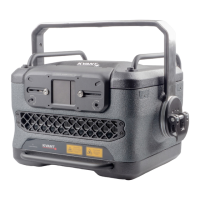10 41
EN
The product warranty does not cover the damages
to the scanning system caused by improper use of the
scanning system orbyincorrect programming. Therefore
itisessential tounderstand how the scanning works and
where are the limits of it. In this manual we will explain
only the basics ofitbut itisthe responsibility ofevery user
toeducate themselves sothey can avoid damage being
caused tothe scanning system and costly repairs.
Alaser beam comes from alaser module and hits the two
moving mirrors ofthe scanning system. These mirrors are
mounted on the scanner shafts and are moved by the
scanner rotors, one onXand one onYaxis.
Aneect such astunnel (circle) isdisplayed byarepetitive
mechanical movement of the scanners. For each
scanning system and eect, there’s a maximal scan-rate
that is defined by mechanical load, scanner mirror size
and weight, complexity of displayed picture and size
ofthe projection (anangle under the laser beam isbeing
projected). A dierent scanning systems have dierent
scan-rate limits. It is essential to operate the scanning
system at scan-rates within its maximal limit at all times
toprevent itfrom overload damage.
How toestablish correct Scan-rate and maximal
number ofpoints inaneect
Each eect (picture) contains adierent number ofgraphical
points which defines the actual shape of the eect. The
more points an eect contains, the lower the maximum
scan rate will beinrelation tothe scanning angle.
Asanexample we’llwork with the star eect shown below
and with the parameters ofquality scanning system:
Let’s say the star eect is made of 300 graphical points
(including non-visible blanking points) and we know that
the maximal scan-rate of our scanning system is “35K”.
(The term “35K” refers toametric that isachieved when
the original ILDA test pattern is projected at 8 degrees,
and all ofits visual qualities are maintained. Note that all
other patterns may bescanned much wider, and insome
cases even faster, but the term “35K” only refers toasingle
test pattern, and single test condition). Wealso know that
wedisplay the star 35 times per second which isadefault
frame rate ofthe control software weare using.
Soweneed todisplay 300 points 35 times per second =
10.500 pps. This means that wecould display 3 ofthese
stars beside each other within one single laser eect and
that itwould bequite close tothe scanner limit (3 × 10.500
= 31.500pps). Given that the scanners noted above are
“35K” scanners, this seems easily achievable. However,
the projection of 3 separate stars necessitates a wider
scan angle, and – in general, the scan speed must
be reduced as the projection angle is increased. Thus,
itmay benecessary toeither lower the number ofpoints
within the eect ordrop down the scan-rate inthe control
software (FPS) toasafe level – which may result inflicker.
for standard types

